Customizable Skateboard Decks: Personalization in Style
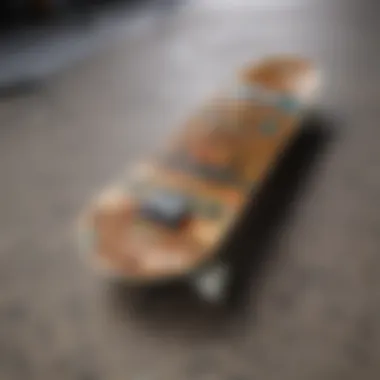
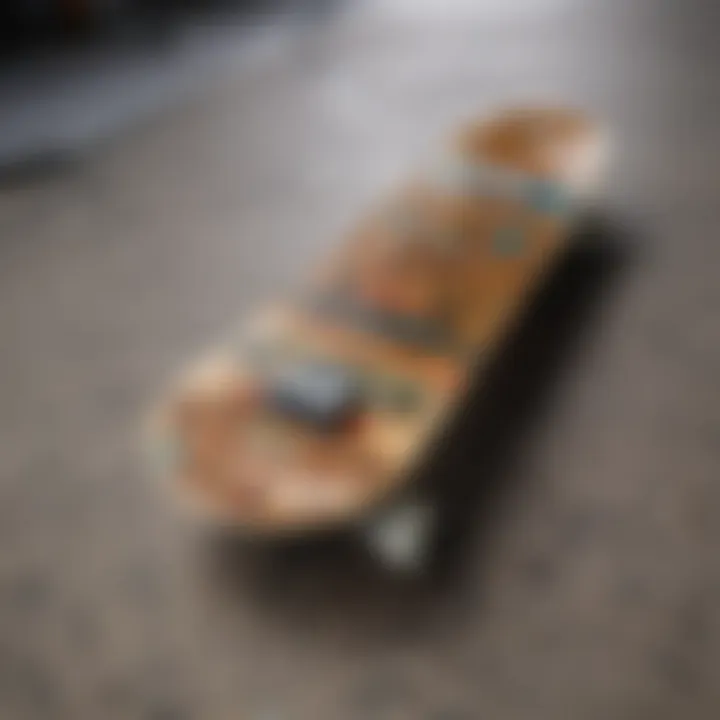
Intro
Customizable skateboard decks stand at the crossroads of personal expression and functionality in the skateboarding scene. They are more than just platforms for tricks; they reflect the identity and creativity of skaters. The choice of deck can influence not just how a board looks but also how it rides. Comprehending what goes into these customizable decks requires a look at various facets from design trends to the colorful culture that has shaped skateboarding over the years.
In the heart of skate culture, customizing a deck is akin to painting a canvas. Every detail matters. It speaks volumes about individual style and skating philosophy. In this piece, we'll dive into the innovative techniques of customization, the skills necessary to make effective changes, and how these modifications can enhance overall performance. We'll also explore how customizable decks echo the evolution of skateboarding from its rebellious roots to a sophisticated form of art.
Techniques and Skills
Essential Tricks for Beginners
For those starting their journey in the skateboard realm, grasping the basics is vital. A solid foundation not only boosts confidence but also enhances the ability to customize effectively. Here are some crucial tricks to get you up and rolling:
- Ollie: The fundamental trick where the rider leaps into the air without grabbing the board.
- Kickflip: Quite a stylish move; this involves flicking the board with your front foot mid-air for some added flair.
- Heelflip: Similar to the kickflip but with a twist—literally! You kick out with the heel instead.
Grasping these basics sets the stage for deeper customization. Consider the shape and size of your deck, as some designs cater better to these tricks. Experimentation is key; many skaters start with a standard shape and, over time, find what feels right for their style.
Advanced Techniques for Pros
As skaters progress, they'll often seek out more complex tricks that require both finesse and precision. A few advanced moves to stretch your skills could encompass:
- 360 Flip: This combines a kickflip and a 360-degree spin of the board beneath you.
- Noseblunt Slide: Balance is crucial here as you slide along an edge while the tail of your board hangs in the air.
- Hardflip: A challenging hybrid trick that melds a frontside shove-it and a kickflip.
Perfecting these can not only impress onlookers but also guide your decisions in deck customization. Each trick might feel more fluid with different materials, shapes, and designs, influencing both performance and style.
Skateboarding Culture
The Evolution of Skateboarding
Skateboarding started as a surf-inspired activity in the late 1940s and early 1950s. Pioneers would attach roller skate wheels to wooden planks, creating a prototype of today’s skateboard. Over the decades, it morphed through various phases, influenced heavily by culture, music, and social movements. The 1970s and 1980s saw the design of wider boards and the introduction of tricks like the ollie, shaped by the likes of Tony Hawk and Bob Burnquist. Today, skateboarding transcends mere sport; it intertwines with art, music, and identity—a movement that celebrates individuality, even extending into customizable decks.
Influential Skateboarders and Their Impact
When discussing skateboard culture, several key figures come into play. Take, for instance, Tony Hawk, whose pioneering spirit has pushed boundaries, making skateboarding more than just a hobby. Or consider figures like Kareem Campbell, who brought a fresh perspective to urban skating and deck art.
Their influence extends beyond the tricks they perform; it's also seen in the designs many skaters choose today. The visuals on a customized deck often draw inspiration from these legends, representing the skater's connection to the broader community.
"Skateboarding is not just a sport; it’s a lifestyle that marries expressiveness with physics."
Understanding the roots and evolution of the sport adds depth to the discussion about customizable decks. It highlights how choices in design and function not only mirror personal taste but also encapsulate the rich history of skateboarding.
In essence, customizable skateboard decks are more than a simple choice of aesthetic. They are a reflection of personal journey and cultural significance within the skateboarding community.
Foreword to Customizable Skateboard Decks
When we talk about skateboarding, it goes beyond just the act of gliding on a board. It's about expressing individuality, embracing creativity, and crafting a personal identity. Customizable skateboard decks play a pivotal role in shaping this identity, allowing skaters to put their unique stamp on something that they ride every day. The choice of design, materials, and modifications not only enhances a skater's performance but also serves as a canvas for personal expression.
The Importance of Personalization
Personalization in skateboarding is not just a trend; it’s a fundamental aspect that allows skaters to truly connect with their boards. A customized deck reflects one’s personality and preferences. Whether it’s a specific graphic that speaks to an individual or a tweak in the shape for a unique feel, personal touches create a stronger bond with the skateboards.
Skaters can feel a sense of ownership and pride, knowing that their deck is one-of-a-kind. This resonates deeply within the skate culture, underscoring the importance of uniqueness in a sport that values individuality.
Additionally, customizing a skateboard deck can enhance functionality. Choosing the right concave or material can improve performance, impacting tricks and stability. Thus, personalization is all-encompassing, blending art and function seamlessly.
Brief History of Skateboard Deck Designs
Skateboard deck designs have evolved tremendously over the decades, mirroring changes in not just design aesthetics but also in riding styles and cultures. In the early days, skateboards were typically made out of wood, with simple designs that catered to a nascent sport.
As the sport gained popularity through the late 1970s and early 1980s, brands began experimenting with shapes and graphics, leading to a wide variety of deck designs. Noteworthy companies like Dogtown and Powell Peralta introduced bold graphics and unique shapes that became sought after by enthusiasts. The "skate or die" mentality began reshaping the skate scene, leading to deck designs that catered specifically to street and vert skaters.
Today, the trend of customization continues with advances in technology and materials. From bamboo decks to eco-friendly options, skaters have a plethora of choices that reflect not only personal taste but also values. Each era contributed to the collective culture of skateboarding, allowing skaters to ride not just a board, but a piece of history and art.
Understanding Skateboard Deck Anatomy
Understanding skateboard deck anatomy is key to customizing a board that suits your individual style and skating preferences. A skateboard deck is not just a flat plank with wheels; it’s a complex structure composed of various elements that influence both performance and personal expression. From the materials used to the curves and features of the deck, every aspect plays a part.
When delving into the specifics of skateboard deck anatomy, skaters can make informed choices that enhance their experience on the board. It’s not only about being flashy with customization but also ensuring that the deck responds well to the skater's body movements, balances weight effectively, and withstands the rigors of skateboarding.
Components of a Skateboard Deck
Material Composition
Material composition of skateboard decks varies widely, often impacting their performance and durability. Most commonly, skateboard decks are made from maple wood, which provides a great balance of strength and flexibility. The unique layering process of laminated wood adds extra durability, which is essential for handling impacts during tricks.
Another popular option is bamboo, known for its lightweight characteristics. This makes it a preferred choice among those who value maneuverability in their skating.
Possible disadvantages? While bamboo is flexible, it can lack the same level of strength compared to traditional maple boards for skaters who perform heavy tricks.
Shape and Size
The shape and size of a skateboard deck dictate how it reacts underfoot. Wider decks offer more stability and are often preferred by skaters who focus on tricks or cruising at high speeds. Conversely, narrower decks can be great for street skaters who maneuver through tight spaces.
Moreover, when customizing a deck, knowing the length impacts your foot placement during various tricks. A shorter deck may be easier for flip tricks, while a longer one can provide more surface area for stability.
Still, it's important to consider that a wider deck might feel clunky to some, and excessive length could add unnecessary weight.
Concave Profiles
Concave profiles refer to the curve of the board's surface, playing a crucial role in the way a skater can perform tricks. Boards can have various types of concave, varying from mellow to steep. A steeper concave generally offers better control for flip tricks and easier landings.
This type of design allows skaters to lock their feet into place, providing a better connection between the skater and their moves. However, a steeper concave could feel less comfortable for casual skating or cruising. It's all about what fits the rider's personal style.
Impact of Deck Design on Performance
Weight Distribution
Understanding weight distribution is vital for achieving optimal performance from your skateboard deck. Where the weight is concentrated can significantly affect how the board behaves during tricks. A well-balanced board allows for smoother landings and increased control in the air.
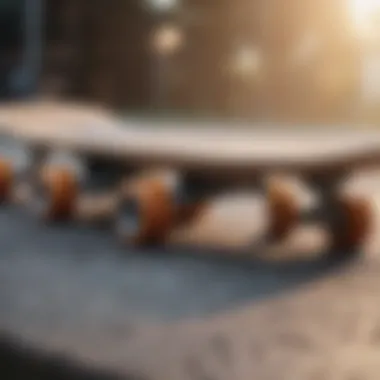
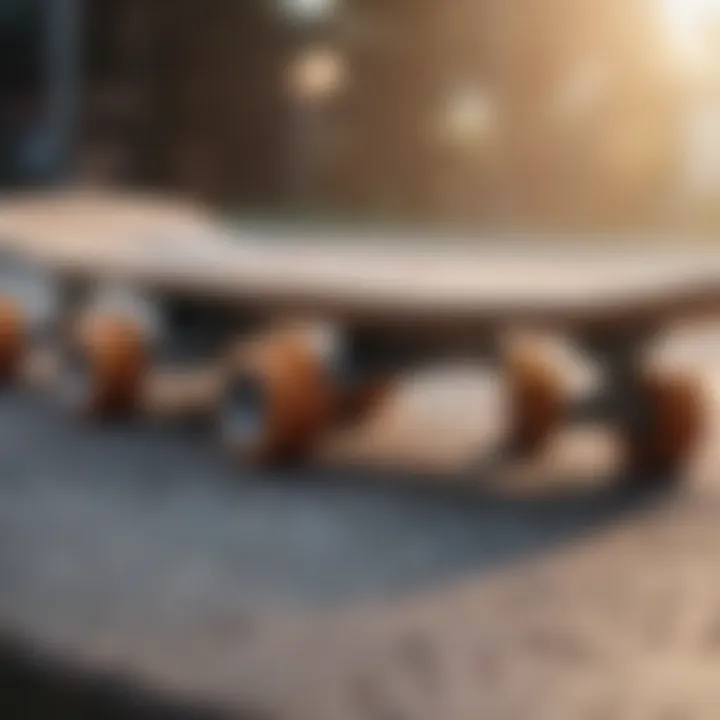
For many skaters, an even distribution is sought after, enabling seamless flips and spins. However, the design can also lead to some skaters preferring extra weight on particular areas to enhance stability for specific tricks.
Flexibility
Flexibility in skateboard decks can be a game changer, especially for skaters who enjoy street or park skating. Boards with more flex provide a greater ability to absorb impact from jumps and tricks, which can lead to improved comfort during intense sessions.
Yet, the trade-off is that too much flexibility can result in less control during high-speed rides. A balance is essential here – finding the flex that matches your style can elevate your skating experience.
Durability
Durability is crucial for any skater, especially those who push their limits. A skateboard deck must withstand daily wear and tear, and the choice of material greatly influences this factor. For instance, decks made from high-quality maple with reinforced layers tend to last longer against impacts.
However, there are trade-offs in terms of weight; as more durable materials can add extra ounces, which could make a difference to agile trick performance. Understanding this aspect means finding a deck that fits your needs while also meeting your expectations for longevity.
Customization Options Available
Customization holds a significant place in the skateboarding world, allowing skaters to express their individuality through their skateboards. As skateboarding evolves, personalization options have become more diverse, effortlessly blending aesthetics with functionality. Customization can dramatically improve the personal connection a skater feels with their board, impacting their overall experience on and off the pavement.
Visual Customization
Graphic Designs
Graphic designs on skateboard decks are more than just a pretty face; they can reflect skaters’ personal styles and tastes. When it comes to the overall impression of a skateboard, a striking graphic is like the cherry on top of a sundae. The brilliance of graphic designs lies in their ability to transform a standard deck into a unique canvas. From bold illustrations to minimalist lines, the choices are virtually endless.
One key characteristic of graphic designs is their versatility. Whether you want your deck to display vibrant pop culture references or intricate art, there’s something to cater to every aesthetic preference. This popular choice among skaters helps solidify an identity and can even serve as a conversation starter in throngs or skate parks.
"Your skateboard is your stage; the graphic is your performance."
However, skaters should keep in mind that some graphics may wear off faster than others, depending on the quality of the print.
Color Choices
Choosing colors for your skateboard can evoke a multitude of feelings and create a strong visual statement. Like selecting your favorite outfit for a day out, colors play a crucial role in how you express yourself through your skateboard. Bright colors can attract attention and communicate energy, while muted tones tend to offer a more sophisticated vibe.
A key feature of color choices is how they can enhance the visual appeal of the board. Gone are the days of limited color palettes; today’s options allow skaters to choose each hue carefully, creating a visual feast for the eyes. This aspect makes color choices a well-loved option in the realm of customization.
Nevertheless, some colors may fade quicker, especially when exposed to the sun for prolonged periods. Choosing a durable finish can help maintain the vibrancy of the colors chosen.
Personal Artwork
Personal artwork is where the heart really shines in customization. Whether it's a doodle from a childhood memory or a piece from your favorite artist, bringing personal elements onto your skateboard can make it truly yours. This option allows skaters to embed memories, philosophies, or motivational quotes right into the deck.
A key characteristic of personal artwork is the deep connection it forges between the skater and their board. Unlike mass-produced graphics, your artwork tells a unique story that others might connect to, helping to build a community around shared values or experiences.
On the flip side, creating personal art can be time-consuming, and for skaters who prefer practicality, it may feel daunting to put pen to deck. But for those who take the leap, the rewards are personal and significant.
Functional Customization
Deck Shape Modifications
Deck shape modifications are like fine-tuning an instrument; they adjust how the board responds to a skater’s movements. Changes in the shape can cater to different skating styles or preferences, whether it’s adding more kicktail for technical tricks or creating a wider stance for stability. The significance lies in how these modifications can enhance performance.
A standout feature is the adaptability of shapes; they can turn a generic deck into a tailored piece fit for an individual’s skateboarding needs. However, careful thought should be put into choosing the right shape, as altering the aspect of a deck may affect its overall immersion.
Material Upgrades
Material upgrades provide an opportunity for better performance and durability, akin to choosing high-quality ingredients for a favorite recipe. Materials used can impact the board's responsiveness, weight, and durability, with options ranging from crafting boards with bamboo for lightweight properties to using maple for a more robust feel.
The beauty of material upgrades is the custom approach skaters can take; none are stuck with one material type. Incrementing durability while maintaining strength is often a sought-after trait of an upgraded material. However, one should be cautious as higher quality materials can come with a steeper price tag.
Grip Tape Selection
Grip tape selection is a small but pivotal component of customizing. More than just a surface for traction; it decides how a skater feels when they land a trick or accelerate. Different textures and grit levels can hugely impact performance, so choosing the right grip tape is tantamount to ensuring safety and performance.
A critical characteristic is that grip tapes come in various colors and designs, allowing for an additional layer of visual customization as well. While some skaters opt for a classic black grip tape for its reliable performance, colorful designs can mirror one’s personality, making it beneficial on multiple fronts.
However, not all grip tapes are created equal, and some may lose their grip or feel rough on the feet faster than others. It's crucial to strike a balance between aesthetics and functionality.
In summary, customization options in skateboard decks allow for a personalized riding experience that resonates with individual tastes and performance needs. Together, visual and functional customizations craft a skateboard that speaks volumes about who a skater is, from the ground up.
The Process of Customizing a Skateboard Deck
Customizing a skateboard deck is more than just a trend; it's a way for skaters to express their individuality. This process is crucial as it allows the rider to make choices that reflect their style and preferences, ultimately enhancing their connection to the sport. When one personalizes a deck, it's like putting a piece of themselves on display. Not only does it serve aesthetic functions, but it also influences performance aspects of the board.
Let's dive into the specifics of how to go about customization, breaking it down into essential steps.
Choosing a Base Deck
Choosing a base deck is the first critical step in the customization process. Selecting the right foundation determines the final result, based on factors like size, shape, and material. The base deck will affect how the skater feels while riding and their performance on various terrains.
When picking a base deck, consider how you skate; street skaters might prefer a thinner, lighter deck, while those who ride in parks might lean towards a more robust design for durability. You might also look at features like the concave, which can affect grip and handling. Providing a solid starting point to all of the customization elements to follow is key.
Applying Graphics and Finishes
Here’s where the fun kicks in! Applying graphics and finishes can turn your blank canvas into a work of art.
Printing Techniques
Printing techniques, such as screen printing or digital printing, are popular choices. These methods allow for various designs on the deck, ranging from vivid colors to intricate patterns. Screen printing, in particular, allows for durability and bright colors that can withstand wear and tear.
One downside? The setup time can be longer than other methods, but once in place, the prints shine. The adaptability to manage custom graphics makes printing techniques a go-to for many skaters wanting something unique.
Hand-Painting
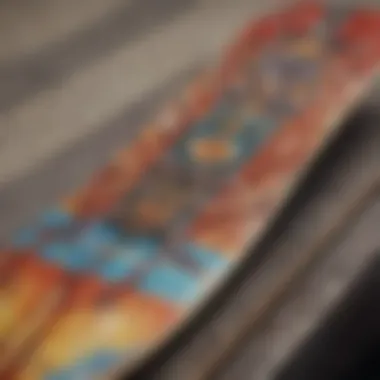
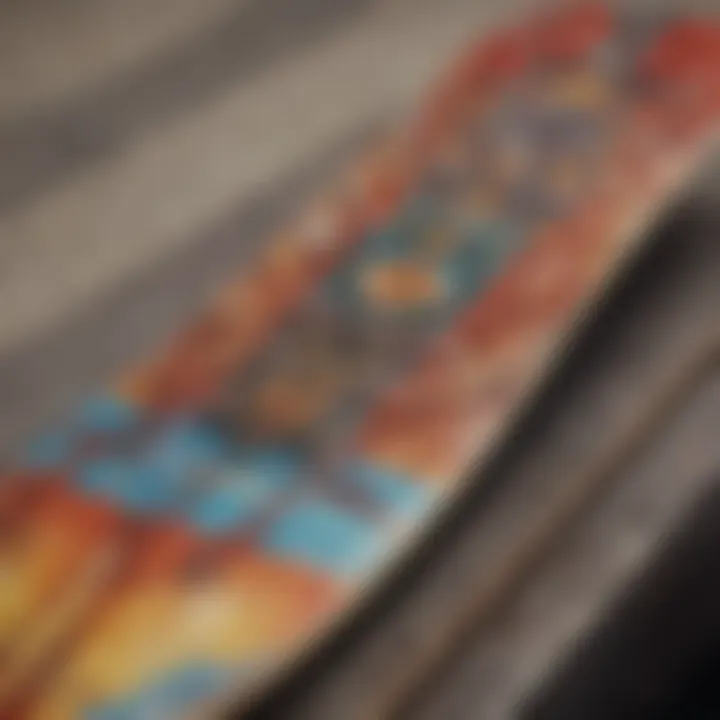
Hand-painting is another route that confirms the uniqueness of a customized deck. This method is not only labor-intensive but also requires skill and creativity. The beauty of hand-painting lies in its imperfections. Each stroke reflects the artist's hand, creating a one-of-a-kind piece.
However, hand-painted decks may require more care than others. Without proper sealing, they might fade quicker than printed ones. Yet, they carry a special charm that some skaters prefer, as they feel more personalized.
Decals and Stickers
Decals and stickers offer an easier yet effective way to customize a deck. They come in various designs, shapes, and sizes, allowing skaters to quickly modify the look without committing to a permanent change. They’re especially useful for those who enjoy switching things up.
But beware – not all decals are created equal. Some may not hold up under rigorous skating, so it's wise to select high-quality options.
Final Assembly Considerations
After customizing the appearance of your deck, the final assembly becomes essential to ensure everything works harmoniously.
Attaching Trucks and Wheels
Attaching trucks and wheels to the deck is no small task. The trucks should align properly with the deck's width to ensure stability. A wise choice of truck height also plays a big role in wheel clearance and overall ride comfort.
An important aspect to keep in mind is the material; choosing durable, lightweight components can significantly impact the overall feel of the skateboard. When the trucks and wheels are correctly attached, you create a solid foundation for a smooth ride.
Ensuring Balance and Performance
Ensuring balance and performance while assembling the skateboard is crucial. This might involve adjusting the tightness of the trucks to achieve the desired turning precision. A well-balanced board makes for more confident riding.
Skateboards that are carefully balanced correspond to better tricks and smoother rides. Testing different setups can lead you to find what feels right for you, improving the overall experience.
Testing the Custom Deck
Finally, testing the custom deck is the last step. It provides a chance to pin down the exact feel of the setup. Taking it for a ride on different surfaces can help you gauge performance — is it smooth? Does it respond well during tricks?
Testing can reveal whether further adjustments are needed or whether you nailed it on the first try. It's an informal practice, but it adds a discerning element to your customized work, ensuring everything feels just right before taking it to the street or park.
"Customization isn’t just about looks; it’s about how the board fits into your lifestyle and skating style."
As you can see, the process of customizing a skateboard deck is both an art and a science. With thoughtful selection, creative application, and careful assembly, riders can create a piece that perfectly matches their style and enhances their skating experience.
Exploring Popular Trends in Customization
The landscape of skateboarding is not just defined by tricks and stunts; it extends to the very boards we ride. Customizable skateboard decks have become a canvas for expression and innovation. Within this realm, popular trends are shaping how skaters view personalization—not merely as a luxury but as essential to their identity within the sport.
Understanding these trends opens up discussions about sustainability, collaboration with talented artists, and the incorporation of cutting-edge technology in design. Each element brings unique benefits to skaters, ensuring that their decks do more than just roll; they narrate stories and showcase individuality.
Eco-Friendly Materials in Deck Customization
As environmental consciousness has surged, so too has the demand for eco-friendly materials in skateboard customization. Skaters are beginning to favor decks made from sustainable resources rather than the standard maple, which often carries a heavier ecological footprint. Examples include bamboo and recycled materials that are not only lighter but also durable.
This trend signifies a key shift in the skateboarding culture: a movement toward responsibility. By opting for green materials, skaters feel they are contributing positively to the planet—a personal statement that aligns their passion with a modern-day ethical stance. While these materials may come with higher upfront costs, the long-term benefit of reduced environmental harm makes this an ultimately favorable choice for conscientious riders.
Collaboration with Artists and Designers
Limited Edition Decks
Limited Edition Decks are not just boards; they're collectibles, featuring unique graphics that speak to specific themes or collaborations. Popular among skaters, these decks often include designs by known artists or brands, giving them a flair that sets them apart from regular production models. The allure of exclusivity drives value—both monetarily and personally—for those lucky enough to own one.
The reinvention of skate decks through artist collaboration expands the narrative of skateboarding culture. However, it does present some downsides. Being limited, these decks can quickly sell out, leading to inflated resale prices that can alienate casual skaters. Still, for many, the investment is worth the personal style and recognition it brings.
Cultural Influences in Design
Cultural Influences in Design highlight the crucial impact of various backgrounds on skateboard aesthetics. This trend pulls inspiration from different art movements, music genres, and even local street art scenes, creating a rich tapestry of visuals on decks. Skaters are not only riding boards but also carrying deep narratives and communities beneath their feet.
The benefit of this trend lies in its ability to foster connection. Skaters can find camaraderie in shared tastes of art and culture, often leading to discussions about heritage and identity. However, the challenge lies in balancing authenticity and commercialization; sometimes, cultural elements can be appropriated rather than celebrated, leading to pushback. Nonetheless, when done respectfully, integrating cultural influences into skateboard design enriches the identity of skateboarding and promotes inclusivity.
Incorporating Technology in Design
Augmented Reality Features
The integration of Augmented Reality features into skateboard designs represents a significant leap forward in personalization. Some companies are beginning to experiment with AR-enabled decks that could provide skaters with interactive experiences. Imagine pointing your smartphone at your deck and discovering a hidden animation or a video related to your favorite skate tricks.
This technology enhances the skateboarding experience by bridging the gap between the physical and digital worlds, allowing skaters to feel connected to a larger community. The downside, however, is the potential cost and accessibility; not every skater may be willing or able to invest in these high-tech boards.
Smart Decks
Smart Decks are another burgeoning trend, equipped with sensors that can track tricks, monitor wear and tear, and even analyze performance metrics. These tools can give valuable insights for skaters striving to improve their skills or just curious about their habits. They add a layer of functionality that traditionally hasn’t been present in the skateboarding realm.
While Smart Decks introduce a level of sophistication to the sport, there are concerns regarding their longevity and practicality. The technology involved can lead to added maintenance, and the reliance on gadgets may detract from the raw, unfiltered joy of simply skating. When balanced correctly, however, this innovation has the potential to complement, rather than overshadow, the skateboarding experience.
"Personalization is at the heart of skating. It’s about more than a deck; it's who you are and how you express it."
In the end, as customization trends continue to evolve, understanding these facets will empower skaters to choose decks that truly resonate with them. Whether through eco-friendly practices, artistic collaborations, or tech integrations, the road ahead promises an exciting blend of creativity and conscious living.
Choosing the Right Customizable Deck for Your Style
Picking out a skateboard deck isn’t just about choosing some wood with wheels. It's an extension of your personality and your skating style. Customization can greatly affect how you connect with the board. The right deck can boost your confidence and performance, whether you’re cruising down the streets or shredding at the park. It’s about finding that match between the deck’s characteristics and your unique skating habits.
Evaluating Your Skating Style
When it comes to skating, two major avenues exist: street and park. Each environment not only shapes how skaters approach tricks but also influences their preference in decks.
Street Skating vs. Park Skating
Street skating is often raw and edgy, using urban landscapes as your playground. It focuses on adaptability and creativity around various obstacles. You’ll notice that street skaters tend to favor a narrower deck. This lighter option allows for quick movement and precision during technical tricks. On the other hand, park skating takes place in more structured environments, comprised of ramps and bowls designed for bigger airs and flows.
A wider deck could be preferable here since it offers more stability when launching into tricks.
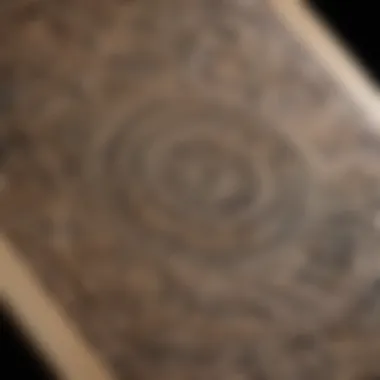

Some skaters might find street skating more appealing because it can integrate unexpected elements, making every session unique. It feels like you can infinitely mix things up, and the environment itself brings its flavor to the table. Yet, park skaters might argue the thrill of mastering challenging ramps can't be beaten. Each style has its merits, and recognizing where you feel most at home is crucial in selecting your deck.
Trick Preferences
Trick preferences play a significant role in your overall skating experience. Tricks fall into categories that often align with either style of skating. If you lean towards street skating, you might enjoy tricks that involve ledges and rails like the boardslide or the smith grind. Here, a lighter deck aids agility for these sophisticated stunts, allowing you to maneuver those tight spots easily.
In contrast, park skaters might pursue aerial tricks like the 360 flip or the grab. A deck designed to withstand heavy impacts and equipped for stability will serve them well.
Your trick choices aren't just about flash; they dictate how you treat your board. Knowing whether you're into technical moves or flying high will influence your deck decision. It might save you headaches down the road.
Budget Considerations in Customization
Once your skating style and trick preferences become clear, the next step is tackling the budget-related concerns that so many skaters face when going custom.
Cost Breakdown
When thinking about cost, it’s essential to consider every little piece associated with customization. Custom decks can vary wildly in price, especially depending on materials, graphics, and brands. You’ll see a range from affordable options and high-end selections. Knocking down how much to allocate for a quality deck initially is vital.
A simple breakdown might look like:
- Base deck: $50 - $150
- Custom graphics: $30 - $120
- Upgraded materials (like bamboo or maple): $40 - $100
If you’re not careful, costs can skyrocket, especially if you aim for limited editions or celebrity collaborations. Thus, laying out a budget can keep you grounded.
Additional Expenses
Don’t forget about the hidden fees that could sneak up on you after finalizing your deck. Things like shipping, assembly, or other modifications can add a few extra dollars to your bill. You may want to budget for:
- Shipping costs for custom graphics
- Tools if you plan on making modifications yourself
- Extra accessories, such as grip tape or stickers to enhance your aesthetics
By not considering these little extras, you could find yourself strapped for cash when all you wanted was to customize your ride. Keeping a comprehensive view of your expenses helps maintain control and ensures you get what you need without breaking the bank.
Ultimately, choosing the right customizable deck means understanding your skating style, balancing your trick preferences, and being mindful of your budget. Each of these elements weaves together to create a well-rounded skater experience, allowing your individuality to shine.
Maintaining Your Custom Skateboard Deck
Keeping your custom skateboard deck in top shape is fundamental for skaters who value both performance and aesthetics. An adequately maintained deck not only enhances the skating experience but also extends the life of your personalized investment. Every scuff, scratch, and worn-out grip can tell a story, but neglecting maintenance can lead to a decline in performance and safety. In this section, we will look into effective cleaning and care techniques, identify signs of wear and tear, and offer preventative measures to prolong the lifespan of your custom deck.
Cleaning and Care Techniques
Establishing a routine maintenance schedule is key to maintaining your skateboards condition. Regular cleaning can help in preserving the graphics and ensuring optimal performance. A simple practice of wiping down the deck with a damp cloth after each ride to remove dust and debris goes a long way.
For more thorough cleaning:
- Use a gentle soap and water solution to scrub stubborn dirt.
- Avoid harsh chemicals that can damage the finish or graphics.
- Ensure you dry the deck completely before storage.
Also, don't forget about the grip tape. It's a magnet for dirt and grime. Replace the grip tape when it’s no longer effective, as a good grip is essential not just for discipline but for safety too.
Signs of Wear and Tear
Recognizing when your skateboard deck has seen better days is crucial for maintaining performance. Pay close attention to:
- Cracks: These can weaken the structural integrity of the deck.
- Fading graphics: If the design starts looking worn out, it might be time to consider a refresh.
- Split or chipped edges: This can affect not just the look but also the performance—you don’t want your deck chipping mid-air during a trick.
When to Replace Your Deck
Knowing when to invest in a new deck is a vital part of skating. If you notice deep cracks or significant warping, these are strong indicators that your current deck has reached its limit. A damaged deck can lead to unexpected failures that may compromise your safety during a skate.
Moreover, a cracked board won’t respond well to tricks, reducing your overall fun. Investing in a replacement deck can also ensure that you have a reliable and creatively appealing ride.
Preventative Measures
Taking steps to prevent wear and tear is like putting money in the bank—worth it in the long run. Here are some proactive measures you might consider:
- Invest in a protective grip tape cover: It helps keep the tape clean and intact.
- Store your board indoors: Avoid exposure to extreme elements like rain or excessive sun, as these can warp or fade your deck over time.
- Using a deck protector: These are small adhesive strips you can place along the edges to prevent chipping.
By practicing good maintenance habits, staying observant about wear, and taking preventative actions, you’ll ensure the longevity of your custom skateboard deck. Your investment in care is truly a reflection of the time and passion you've put into personalizing your ride.
Community and Culture of Customization
The skateboard scene thrives on a potent blend of creativity and individuality. This culture isn't just about the tricks and flips; it's also about expression and identity. Customizing skateboard decks is where art meets sport, allowing skaters to manifest their unique styles through their gear. The community plays an indispensable role in shaping these customs, as members exchange ideas, showcase their designs, and inspire one another. This section digs into the vibrant culture surrounding customizable decks and highlights the importance of these interactions.
Engaging with Local Skate Communities
Local skate communities are like family, often bringing together individuals from diverse backgrounds who share a common love for skateboarding. Joining these communities offers skaters several benefits:
- Collaboration and Inspiration: When skaters gather, new ideas often sprout. One might spot an innovative graphic or a deck shape and think, "Hey, that fits my style!" This collaboration leads to a thriving pool of artistic expressions.
- Support and Learning: Engaging with experienced skaters allows newcomers to learn tricks, techniques, and customization tips. Whether it's about the right paint for a deck or the best type of grip tape, shared knowledge enhances everyone's skating journey.
- Events and Meetups: Many communities organize events, from local jams to workshops. These gatherings provide a platform for skaters to flaunt their custom decks, share stories, and build friendships—everyone's skating path intertwines here.
To join these communities, skaters can look to local skate shops, social media platforms, and online forums, like Reddit, where discussions flourish.
Showcasing Custom Decks: Competitions and Events
Competitions and events centered around custom skateboard decks are a fantastic way to celebrate creativity while bringing the community together. These gatherings can vary in scale, from local contests to national showcases:
- Local Competitions: Smaller events hosted by skate shops or community centers often feature categories specifically for custom decks. Skaters have the chance to win prizes and recognition for their unique styles.
- Art Shows and Exhibitions: Some events focus solely on the art aspect of skating, where skaters display their decks like canvases. Viewers are encouraged to appreciate not just the design but also the skill involved in creating it.
- Collaborative Projects: Artists and skaters often team up for charity events, creating limited-edition decks. These special pieces tell a story, blend cultures, and often help raise funds for important causes.
"In the world of skateboarding, every deck tells a unique story. Customizations aren’t just aesthetic; they embody the spirit of the rider."
Engaging in these competitions and events nurtures a sense of community. Skaters admire each other’s work and often walk away inspired to push their creativity further. The culture of customization thus stands as a testament to the individuality and solidarity found within the skateboarding world.
Ending
Customizable skateboard decks stand at the intersection of art and athleticism, embodying both personal expression and the technical demands of skating. In this article, we have traversed the vibrant landscape of customization, exploring its significance and impact on the culture surrounding skateboarding.
The Future of Customizable Skateboard Decks
The future of customizable skateboard decks seems bright and full of potential. As technology improves and the materials used in decks become more advanced, we can expect to see even more options available to skaters. For instance, with the integration of smar tech and augmented reality, decks may soon allow skaters to visualize how their changes will look even before committing. Moreover, sustainable materials will likely continue to gain traction. Many brands are pushing for eco-friendly solutions, which not only benefits the environment but can also appeal to the growing community of conscious consumers.
Embracing Individuality in Skateboarding
Embracing individuality in skateboarding is what makes the sport truly unique. Each deck tells a story, reflecting the personality and preferences of its owner. It’s not just about how a deck looks; it’s about the feelings and experiences behind it. Skaters from all walks of life find freedom in customizing their gear, allowing self-expression to take center stage. From designs inspired by local artists to personal graphics that hold a special place in their hearts, the individuality showcased in decks fosters a deeper connection between skaters and their equipment. Furthermore, this personal touch can enhance the performance of the board as it becomes an extension of the skater’s identity.
"Customization is not just a process; it's an expression of who you are on the board."
Customizing your skateboard deck means you're not just part of a sport; you're part of a community that appreciates creativity, freedom, and individuality. As more newcomers join this culture, the potential for fresh ideas and collaborations continues to grow, making skateboarding a dynamic form of artistic and athletic expression.







